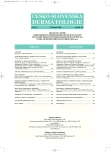Androgenetic Alopecia and Finasteride Treatment
Androgenetická alopecie a léčba finasteridem
Androgenetická alopecie je charakterizována relativně zvýšeným výpadem vlasů a postihuje obě pohlaví. U mužů je nejčastější příčinou ztráty vlasů, u žen má rozdílné projevy a mnohem nižší prevalenci. Výpad vlasů může být spojen s psychosociálními problémy. V léčbě androgenetické alopecie se začal využívat finasterid - blokátor 5α-reduktázy, který brání přeměně testosteronu na dihydrotestosteron.
V naší studii jsme vyšetřili 26 mužů s předčasným výpadem vlasů před 30. rokem. Tito muži užívali 3 měsíce finasterid v dávce 1 mg/den. U všech probandů jsme vyšetřili androgenní spektrum před léčbou a po léčbě finasteridem. Laboratorní výsledky ukázaly statisticky významný rozdíl v poměru testosteronu k dihydrotestosteronu před léčbou a po léčbě. V ostatních hormonech androgenního spektra nebyly v této prospektivní případové studii zjištěny rozdíly před léčbou a po léčbě. Skupina 17 probandů po 3měsíční léčbě uváděla snížení výpadů vlasů a zlepšení jejich kvality, byli s léčbou spokojeni a chtěli v ní pokračovat.
Klíčová slova:
androgenetická alopecie - finasterid - testosteron - dihydrotestosteron
Authors:
M. Dušková 1; L. Stárka 1; M. Hill 1; I. Čermáková 1; M. Doležal 2
Authors‘ workplace:
Endokrinologický ústav ředitel doc. MUDr. Václav Hainer, CSc.
1; Klinika plastické chirurgie 1. LF UK a Fakultní nemocnice Na Bulovce přednosta doc. MUDr. Jan Měšták, CSc.
2
Published in:
Čes-slov Derm, 81, 2006, No. 6, p. 326-329
Category:
Clinical and laboratory Research
Overview
Androgenetic alopecia is characterized by relatively increased hair loss and affects both sexes. In males it is the most frequent cause of hair loss, in females it has different signs and much lower prevalence. Hair loss may be associated with psychosocial problems. Finasteride – blocker of 5α reductase, interfering with the transformation of testosterone to dihydrotestosterone has been introduced into treatment of androgenetic alopecia .
We examined 26 males with premature hair loss by 30 years of age. They were treated by finasteride 1 mg a day for 3 months. In each of them the androgenic spectrum was examined before and after treatment. Laboratory tests showed statistically significant difference in the testosterone/dihydrotestosterone ratio before and after treatment. No such differences were found in other hormones of androgenic spectrum in this prospective study. After 3 months of the treatment 17 patients indicated hair loss reduction and better hair quality, they were satisfied and willing to continue the treatment.
Key words:
androgenic alopecia – finasteride – testosterone – dihydrotestosterone
Labels
Dermatology & STDs Paediatric dermatology & STDsArticle was published in
Czech-Slovak Dermatology

2006 Issue 6
Most read in this issue
- Androgenetic Alopecia and Finasteride Treatment
- Cutaneous Mucinoses
- Skin Sebum Measurement – Sebumetry
- “Windmill flap” in the Wound Closure on the Scalp
